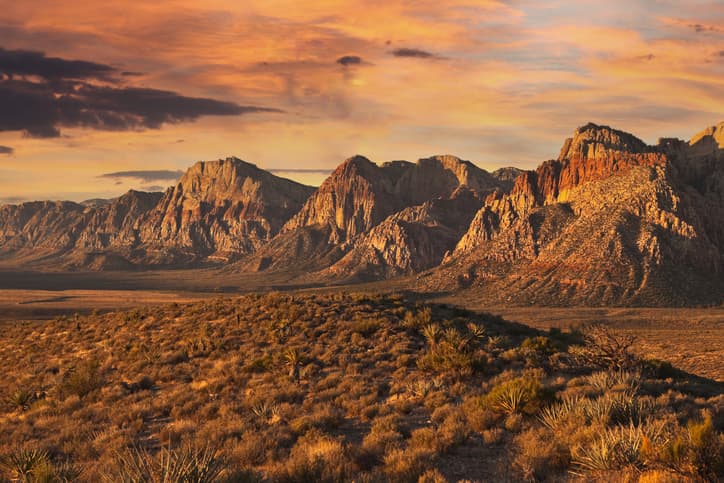
After all the glamorous bright lights and action of Las Vegas, you might want to take a break and enjoy a new adventure outdoors in the Nevada sunshine. Las Vegas is surrounded by a desert land of ancient-formed Aztec sandstone rocks and cliffs. Close by are amazing national and state parks you can easily explore in a day.
We recommend starting with Red Rock Canyon. It is a 30-minute drive west of the Las Vegas strip, making it an excellent day trip for sightseeing the natural beauty of the Mojave desert. To get there, take Charleston Boulevard (State Highway 159) to the Red Rock visitors center. Parking is included with the entry fee of $15 per vehicle.
When is the best time to visit Red Rock Canyon?
From October 1 to May 31, a timed entry day pass is required to see the 13-mile scenic drive. Visiting hours are 8 a.m. to 5 p.m. daily. In the winter months – November through February – the park opens two hours earlier, and it stays open two hours later in the summer months. It’s also open on holidays. There are 12 different trailheads with parking areas allowing you to get out of the car and explore on foot. Keep in mind the drive is one-way in direction, but you can re-enter the park on your same-day pass.
What can you see and do at Red Rock Canyon?
Start at the Red Rock Canyon Visitor’s Center first to learn about the area’s history. Four unique outdoor interactive exhibits have themed earth, air, fire, and water elements to educate visitors. Additionally, there is an indoor visitor center with a gift shop and helpful staff to answer your questions. Be sure to get a map showing the 26 numbered hikes and trails within the 198,000 square mile canyon land. Hikes are rated easy to difficult, going from less than a quarter mile to 14 miles long.
Red Rock Canyon offers many things you can see and do, including picnics, mountain biking, climbing, hiking, camping, horseback riding, photography, and discovering the flora and fauna of the Mojave desert. Temperatures can get very hot in the summer, so it is advised to bring at least one gallon of water per person if going on a hike.
Animals, plants, fossils, and dinosaurs
Red Rock Canyon is home to a variety of animal and plant species that you might be lucky enough to spot on a hike. Native plants are Mojave Yucca, Prickly Pear Cactus, and Joshua Trees. In late spring, many of these plants display colorful flowers.
Some of the native animals are Bighorn Sheep, Burros, Desert Tortoise, Gambel Quail, Chuckwalla Lizard, and the White-Tailed Antelope Squirrel. In 2012, the Red Rock Canyon herd management adopted a wild burro on the lands and named him Jackson. This cute little burro is used for visitor educational programs, and you can like his Facebook page here.
There once was abundant animal and water life millions of years ago when Red Rock Canyon was an ocean. Today, you can see fossils and dinosaur tracks in the Blue Diamond Hills on the east side of Hwy 159, in the hills of Cottonwood Valley south of SR-160, and on the tops of limestone mountains behind the Red Rock escarpment.
What is the history of Red Rock Canyon?
Red Rock Canyon was formed during the early Jurassic period 190 million years ago. The cliffs are thousands of feet high and get their reddish color from iron oxides and porous qualities from calcium carbonate deposited by water running through the Aztec sandstone.
In 1990, government legislation changed the name from Red Rock Recreation Lands to the Red Rock Canyon National Conservation Area (RRCNCA) to protect and preserve the area. It was one of seven to be specially designated in the United States and is managed by the Bureau of Land Management (BLM). Two million people visit RRCNCA annually to enjoy the spectacular desert scenery.
Join in the preservation of Red Rock Canyon National Conservation Area, adhering to the outdoor ethics of the Leave No Trace program as you enjoy Nevada’s public lands.
What other day trips can you take from Las Vegas?
After seeing the natural beauty of Red Rock Canyon, you might want to learn more about the secrets of the Mojave Desert on a private tour with Gray Line Bus to the Valley of Fire, located 45 minutes north of Las Vegas. You will learn about the ancient petroglyphs visiting Nevada’s oldest and largest state park. This 7-hour day tour leaves from many Las Vegas hotels.
Plan your day trip to Red Rock Canyon
Now that you know Red Rock Canyon is not too far from Las Vegas, you can plan your trip accordingly, making at least one full day for a visit. Bring a pair of good hiking shoes, sun hat, sunscreen, water, and snacks. Head on over to the Red Rock Visitor’s Center as your starting point of information, then set out to discover all that Red Rock Canyon Nature Conservation Area offers for an outstanding day trip out of Las Vegas.
Leave No Trace. (2021).
Outdoor Ethics. (2022).
Red Rock Canyon National Conservation Area. (2022).
Red Rock Canyon Scenic Drive Timed Entry. (2022).
Valley of Fire State Park. (2022).